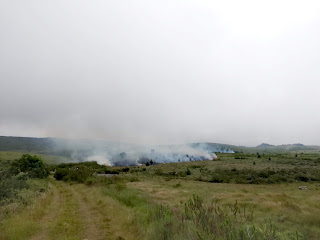Fire Starters: Patch Mosaic Burning in the Grassland Biome – Nicolas Theron
The Kruger to Canyons Biosphere Region (K2C) in partnership with The Mpumalanga Tourism and Parks Agency (MTPA), SAFCOL/Komatiland Forests and the Department of Agriculture, Forestry and Fisheries (DAFF) is currently embarking on a process to declare over 5 000 ha of high value conservation land in the Mpumalanga Drakensberg. As part of the process management plans are being developed for these areas which mostly consist of threatened grassland, wetland and forest habitats. Fire is a key ecosystem driver in many biomes, including grassland, savanna and fynbos ecosystems in South Africa and thus fire is used as a crucial management tool by land managers to help meet a number of objectives.
In a forestry setting a balance needs to be struck between ensuring the safety of plantation trees while also attempting to promote biodiversity in these natural areas. The Mpumalanga Tourism and Parks Agency (MTPA) over the course of the last 40 years has experimented with a number of fire techniques on Blyde River Canyon Nature Reserve (BRCNR) largely driven by Frik Bronkhorst and others. Due to the undesirable ecological impacts of certain burning techniques and the practical difficulties in terms of the resources needed to implement burns on a scale that would limit ecological impacts, a system of trying to mimic fires caused by lightning was implemented. This led to the implementation of patch mosaic burns (PMB) on the BRCNR as well as Manyeleti Nature Reserve bordering the Kruger National Park. The PMB technique was first explored by Parr & Brocket in the late 1990's to maximize the benefits of a diverse fire regime that promotes heterogeneity in a landscape thus supporting species diversity. The PMB fire regime applied at several MTPA estates is characterized by fires ignited throughout the year, under cool moist conditions and allowed to burn freely with the return period primarily dictated by the presence and abundance of moribund material. Patch mosaic burning has been identified as a means to support biodiversity objectives in a forestry landscape, especially as a way to reduce moribund material in the absence of large herbivores, thus reducing fire risk and also supporting biodiversity objectives.
On the 21st February MTPA initiated a patch burn on BRCNR and a number of stakeholders were invited to attend. The day was preceded by a number of days of rain and mist and many thought burning would not be possible. However, with the help of a slight wind the grasslands readily burnt and the operation was safe enough for my two sons David and Benjamin to get involved and hopefully satisfy their curiosity in all things fire, not helped by the enthusiastic encouragement of MTPA staff!
Patch burning as a method for application in a forestry landscape will be further investigated in the coming months and although it can’t address all management requirements it can be used in conjunction with other types of burns to support biodiversity outcomes. We also hope that some of this work could lead to increased interest with the potential to focus on addressing the lack of research on patch mosaic burning, especially in the grassland biome.





Comments
Post a Comment